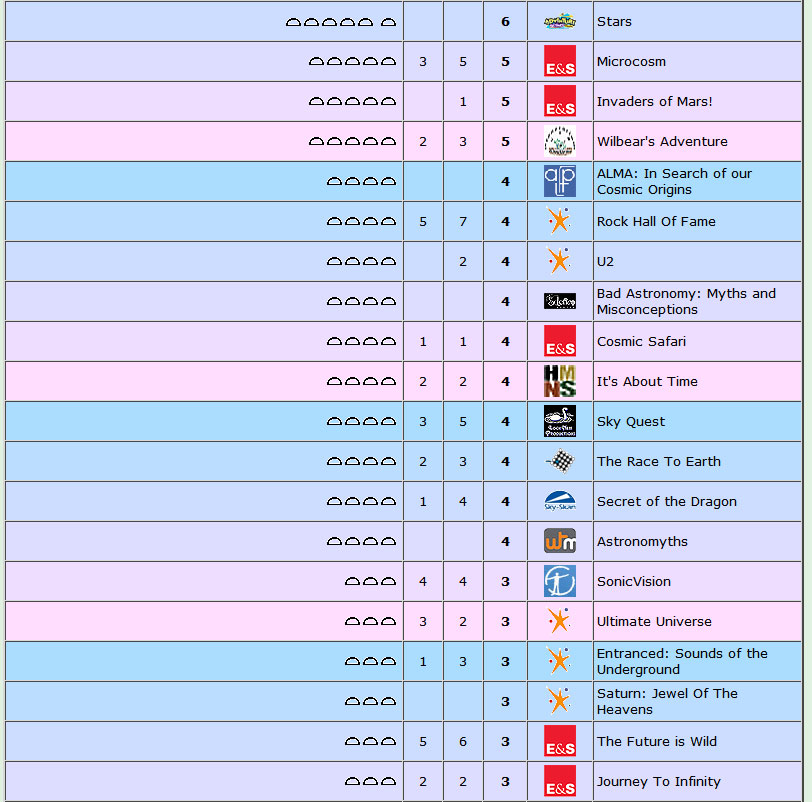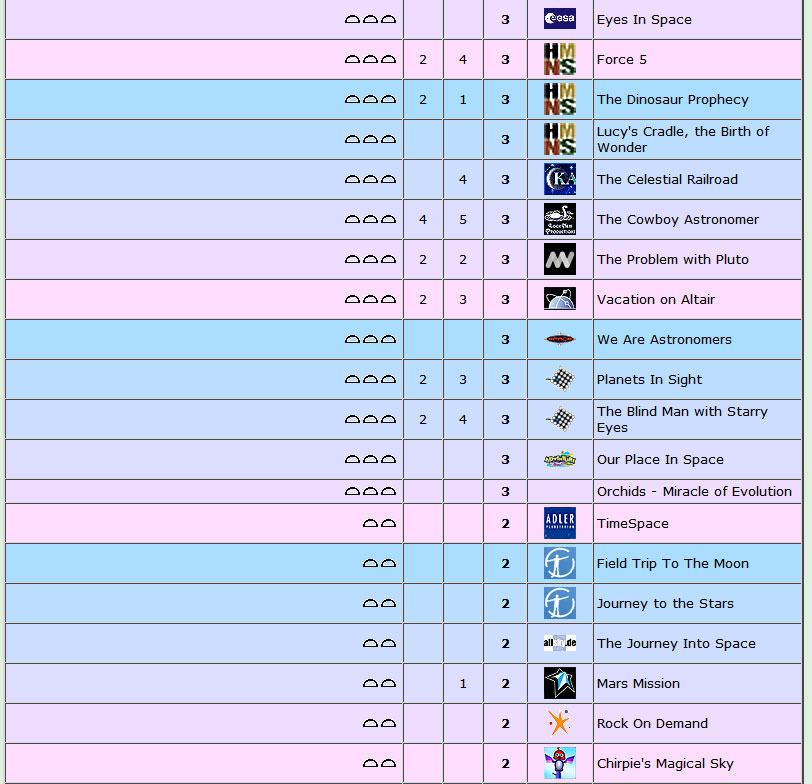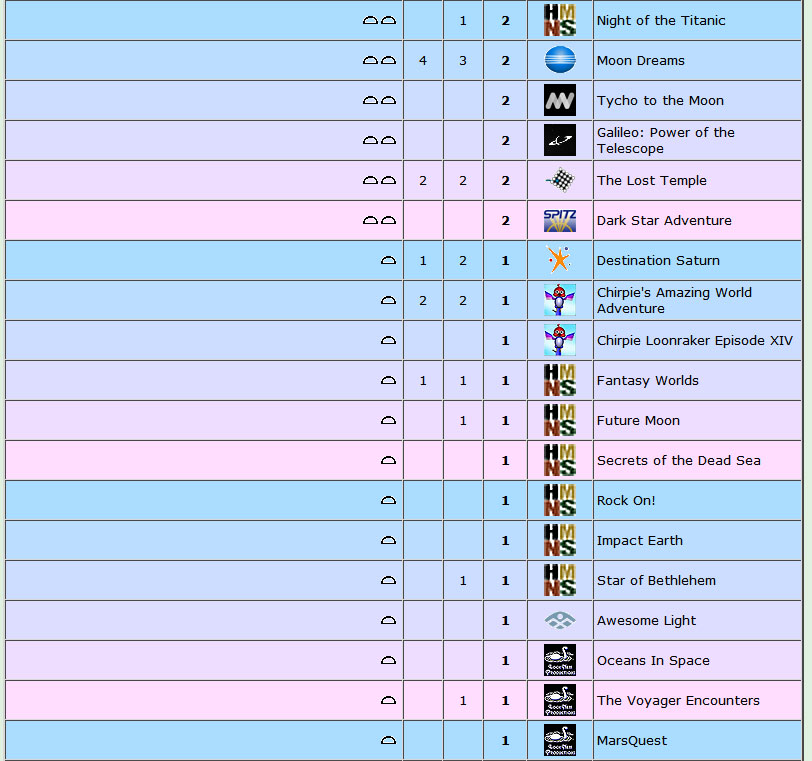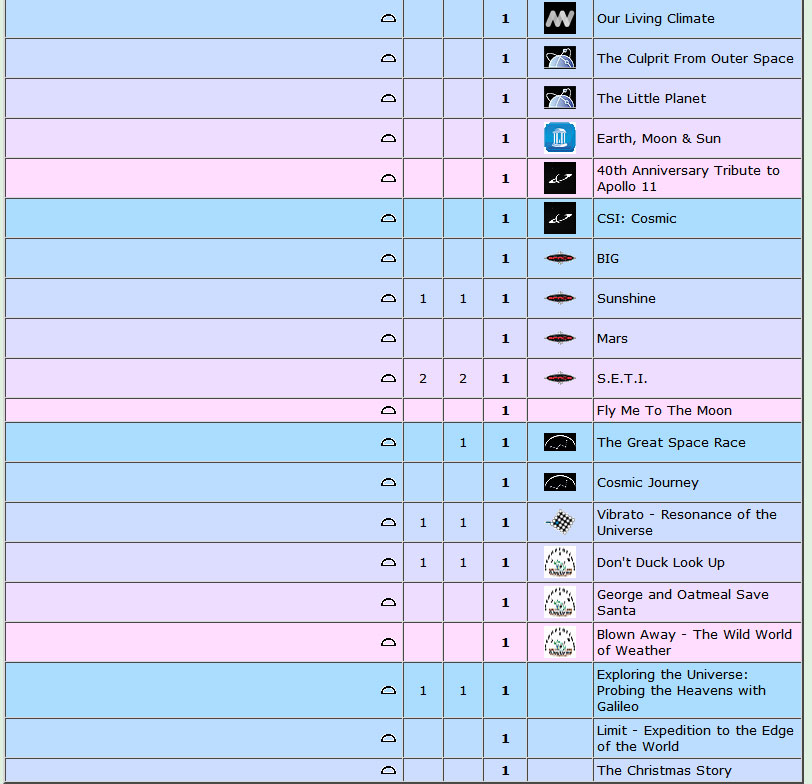|
The 2009 State of the Dome Address by Mark C. Petersen, Loch Ness Productions A presentation for Domefest 2009, Albuquerque, New Mexico, September 2009 © 2010, Loch Ness Productions |
|
Abstract. As perspective for pondering the future of fulldome as a medium and market, it might be useful to review its current state. Statistics drawn from Loch Ness Productions' LNP FULLDOME THEATER COMPENDIUM ONLINE! are presented and discussed, and provide some answers to the quintessential questions: "Who are we, where are we, and what are we doing?" |
(2011 note: presentation edited to make active links of referenced Web resources.)
Since 2004, I've maintained data on every fulldome theater in the world I find out about, and make a listing available on the Loch Ness Productions Web site. It's called the LNP FULLDOME THEATER COMPENDIUM ONLINE! and you can access it directly at this URL:
www.lochnessproductions.com/lfco/lfco.html
There is the usual address and contact information, dome sizes, seating arrays, projector systems, and attendance reports. And there are many other features, such as Skype-able phone numbers and fulldome projector manufacturer links. The raw data are all there.

There aren't any tabular summaries of the data online (that's a feature included in our commercial product). But, anyone dedicated enough could comb through the pages and compile summaries themselves. I've done that for this presentation, to create a "snapshot view" of the online listings as they existed on 21 September 2009. Of course, the numbers constantly change as I receive updates provided by theater operators, vendors, news updates, and customers. I've made similar data analyses in 2007 and 2008, and I'll compare those numbers with this year's tallies.
There is one "summary" feature visible online: the total number of listings. As of 21 September 2009, I list 579 entries. In two years, the number has more than doubled! That's a remarkable — dare I say phenomenal — growth rate. There's an even split — basically half are in the U.S., and the other half are in the all the rest of the countries of the world combined. So I've kept track of American figures separately from the international numbers.

Looking at the some of the summary tables, we see that — in terms of number and size of domes — larger domes predominate internationally, while mid-size domes are more plentiful in the U.S. More seating configurations are front-facing, compared to concentric seating (though there's a large "unknown" factor here). The overwhelming majority of theaters are associated with some form of educational or cultural institution, which is significant if you are a show producer evaluating fulldome as a "market".
I included an "Annual Attendance Projection" — but there are many, many caveats with regard to this 35 million number. I explain them and the methodology used to estimate this figure on these Web pages:
www.lochnessproductions.com/pltref/attend.html
www.lochnessproductions.com/pltref/more_attend.html

The Projector Systems
For 2009, I tallied the number of projector systems in the listings (note that several theaters have more than one fulldome system). I counted 638 projectors this year, up from 498 last year — and again, more than double the figure from 2007. Of those, nearly two-thirds of the listings are the single-projector systems, usually displaying movies at around 1K resolution. In other words, in the fulldome world, the little guys are the biggies.

Then, I sorted the projector systems by their makers to get an idea of whose systems are the most popular.

It should come as no surprise to anyone in the field to note that Evans & Sutherland and Sky-Skan are battling it out at the top, with E&S maintaining a little edge in installation numbers. Coming in a strong third this year is the Discovery Dome from ePlanetarium.
The validity for the numbers for the major hardware manufacturers should be pretty good; they often provide such information either on their own Web sites, or directly to me. However, with some of the portables, there's more than meets the eye. Digitalis Education Solutions and STARLAB have policies about not releasing their customer information. But, Digitalis has said they have more than a hundred more systems out there that I don't have address information for. Anecdotally, I've been told the number of Digital StarLabs could be triple what I list. If you take these unlisted system counts into consideration, the total number of systems goes to more than 800. Stated more obviously, three out of four fulldome systems in the world today are the single-projector 1K- resolution type.
In any case, it's a reasonable extrapolation to say within the next year or so, we'll see the tally expand to more than a thousand fulldome systems. Pretty amazing, I'd say.
I do include portables in the LNP FULLDOME THEATER COMPENDIUM ONLINE! although it may be an interesting discussion point about whether an inflatable dome qualifies as a "theater". That's a philosophical debate for another time, however. From Loch Ness Productions' viewpoint, if a system can show our fulldome videos on its dome, it counts as a theater!
The Shows
So, what are people showing on their domes? Since we include Web sites in the Compendium listings, I simply surfed to each and every one — all 333 of them — looking for their show listings and noting the results. Yes, I am a glutton for punishment, it would appear. It only took me several days to do...

Of what I consider profound significance: many of the Web searches for shows turned up nothing. In fact, only on 26% of the sites could I even find a list of show offerings. One could deduce that three out of four fulldome theaters do not present commercially-produced fulldome videos to the general public. Or, perhaps they just don't want people to know what they're showing. Who knows? For judging a potential market for programs, though, this should give people pause for thought.
This year, I found 150 theater Web sites that did list shows. Some only displayed the "current feature", while others apparently offer every show they're ever bought — several facilities have more than 25 shows on tap. One cannot easily judge "what's hot and what's not" from such listings. There are variables regarding license periods — for example, some shows may have "timed out" and can no longer be shown. Others listed as available might be shown only by special request; they're not really in active rotation. Unlike classic planetarium theaters, though, it takes just a click of a mouse to call up any or dozens of shows; no running around in the dark, climbing ladders to change slide trays.
I found 117 unique show titles mentioned. 157 is my count of the total number of show titles commercially available — a listing we also maintain on the Loch Ness Productions Web site.
One needs to keep in mind that my count is just a snapshot of the state of these Web pages in September 2009. For example, you won't find many mentions of Christmas/winter holiday shows in September.
For the last two years, the most frequently mentioned show was Clark Planetarium's "Secret Of the Cardboard Rocket." It would have been this year, too — except it was bested by the IYA show "Two Small Pieces of Glass". It was no surprise to find 42 theaters had it in their repertoire to go along with their International Year of Astronomy activities. That it was distributed free (or for the cost of a hard drive) may have worked in its favor, too.
The other leading titles from previous years continued in their popularity, and it looks like the new entries from AVI, Clark, Houston and Sesame Workshop are being well-received.






As I did with the projector systems, I then sorted the show titles by producer.
For 2009, the top 3 producers maintained their popularity from previous years — E&S, Clark, and then — Loch Ness Productions! Hooray, we're #3! The inclusion of Houston's shows coupled with the popularity of ePlanetarium systems may account for their rise in the standings.


Finally, I'd like to mention a feature of the Compendium on which I've worked particularly hard. I've included latitude and longitude coordinates for each fulldome theater, and you can select the Google Earth link in the listing to go there using that application. You can also download the FULLDOME.KMZ file — which has Placemarks for every theater on the globe.

Until next year, that's it for now. If you find this information useful, please go here or here.


